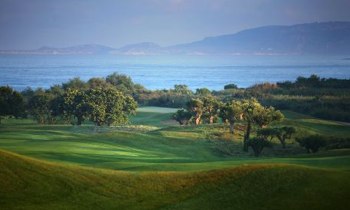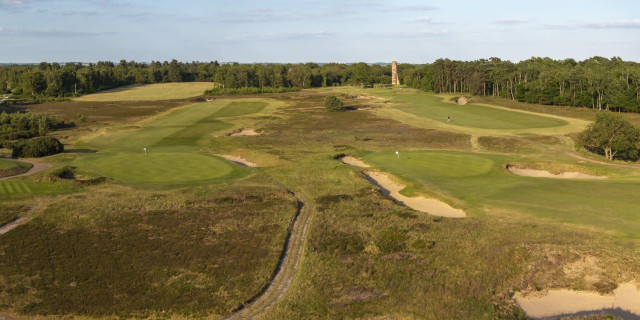
Golf in Greece
 Greece has always been one of the most coveted tourist destinations in Europe, thanks largely to an unrivalled and unparalleled combination of climate, scenery, cultural heritage and nightlife. But as interest in golf increases around the globe, people are increasingly seeking out destinations that can marry the traditional beach holiday with a high quality golfing experience. Greece is another European country without a discernible golfing heritage, but a number of quality resorts have sprung up over the past few years, with many more in planning stages. Some big names in golf, such as Bernhard Langer and Nick Faldo, have been attracted to Greece’s shores in recent times, and it is easy to see why: the country has almost limitless potential as a golfing destination. Granted, Greece’s economic uncertainly and austerity measures may affect prospective development, but with many resorts offering cut price deals and recognising the significance of increased tourism in the midst of economic decline, there has never been a better time to golf in Greece.
Greece has always been one of the most coveted tourist destinations in Europe, thanks largely to an unrivalled and unparalleled combination of climate, scenery, cultural heritage and nightlife. But as interest in golf increases around the globe, people are increasingly seeking out destinations that can marry the traditional beach holiday with a high quality golfing experience. Greece is another European country without a discernible golfing heritage, but a number of quality resorts have sprung up over the past few years, with many more in planning stages. Some big names in golf, such as Bernhard Langer and Nick Faldo, have been attracted to Greece’s shores in recent times, and it is easy to see why: the country has almost limitless potential as a golfing destination. Granted, Greece’s economic uncertainly and austerity measures may affect prospective development, but with many resorts offering cut price deals and recognising the significance of increased tourism in the midst of economic decline, there has never been a better time to golf in Greece.
Climate
It is hard to imagine a better climate in which to play golf all year round. The country basks under clear, sunny skies for over two thirds of the year. Summers are long and dry, with temperatures often reaching 37 Degrees Celsius in the mountainous North. Many tourists favour southern areas of Crete, Rhodes and Athens, where average summer temperatures are an affable 27 degrees, with around 12 hours of sunshine per day in July and August. Some prefer to visit in April or May, when temperatures fall to around 20 degrees and cooling ocean zephyrs sweep in from the Med and Aegean sea.
Other attractions
Whilst Greece doesn’t possess a whole host of championship golf courses at a consistently high quality, it’s off course attractions are second to none. Ancient palaces abound in Athens, Crete and northern areas, such as Halkidiki. Gorges and mountainous areas provide wonderful hiking opportunities, with views of the Mediterranean and Aegean coasts and numerous Greek islands. If you are stationed on the mainland, high-speed hydrofoils simplify the process of ‘island hopping’, seemingly the only thing at odds with Greece’s languid pace of life. Once island bound, you can set about planning trips to various secluded or more public beaches, surrounded by picturesque, rugged coastline and the teal blue waters of the Aegean Sea.
There are many cultural activities on offer in Greece, a country which played a significant role in forming Europe’s own cultural identity. Many chose to visit the imposing Temple of Zeus and the Acropolis in Athens, local mineral baths and museums in Corinth, or take part in many Greek folk festivals and celebration during Easter’s carnival season. The nightlife is as good as anywhere in Europe, accompanied by great restaurants and fine wine, and sports and recreational activities abound.
Golf in Greece
There is so much happening in Greece you might forget the main purpose of your trip: golf. Two courses that simply must be played on any visit are Bernhard Langer’s Dunes Course at the Costa Navarro resort, some 170km south of Athens, and the Crete Golf Club.
The championship standard Dunes course opened in 2010, and is considered the best resort on the island and one of the most beautiful courses in Europe. It is located in Messinia, Greece’s most fertile land, and is filled with a wide array of endangered wildlife. The course has been set-up to resemble a links, with dunes (hence the name) shaped to separate some of the holes closest to the sea. The links character is further emphasised by deep pot bunkers and sloping greens, but as the course moves inland, its character changes. As it moved further away from the sea, the course meanders through lemon and olive groves, giving a more traditional Greek feel. The diverse topography ensures spectacular sea and river views, with outlines of distant mountings coming into view on several holes.
The course itself is perfectly manicured, despite being crafter across natural terrain, and prides itself on being kept in pristine condition. The aim of the designers was to create a course that would be fun for the average player whist providing a challenging test for low handicappers. The course, 6800 yards from the back tees - is characterised by generous fairways and large greens, but strategically placed bunkers demand accurate shotmaking. The putting surfaces are undulating, with many green split into plateaus and steep slopes between the levels. The variation of the course is another stand out feature. There are long, testing par-4s mixed in with driveable holes, and all the par-5s are reachable but littered with hazards.
The resort possesses another golf course (the Bay Course) - opened in 2011 and designed by renowned architect Robert Trent Jones – which provides sublime views as it switches between seaside, canyon and grove. Costa Navarro also boasts a full size driving range, a short game area with the largest putting green in Europe, and a 3,500m2 clubhouse, where you can enjoy a post-round meal and beer and watch the sun set over the Mediterranean sea.
The Crete Golf Club is another course popular with tourists, and is currently ranked as the 3rd best course in Greece. It was designed by PGA Design Consulting’s Bob Hunt, and was laid out to USGA standards over rugged mountain terrain in Hersonnisos. It regularly hosts the Aegean Open, with golfers using many superlatives to describe the course and views of the surrounding area. The main attraction is a quartet of unforgettable par-3s, most notably the 6th hole. It is 198 yards from the back tees, with tee shots having to carry a deep gorge to find a two-tiered green cut into the foot of a hillside.
Greece isn’t renowned for golf, and the economic crisis will undoubtedly hamper further developments, but some of its courses are magnificent, the climate and setting are perfect, and the out-of-golf attractions and activities are second to none. With cheap prices on offer from www.golfbreaks.com, a golf holiday in Greece warrants serious deliberation.
Related Content:

















